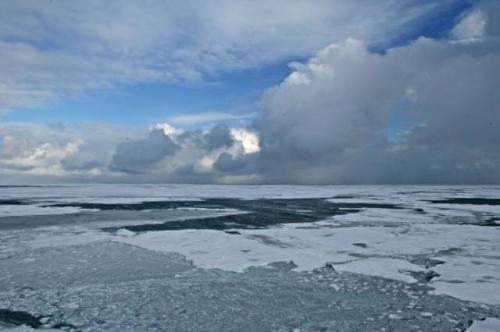Ocean circulation explains why the Arctic affected by global warming more than the Antarctic

Over recent decades, scientists have watched a climate conundrum develop at the opposite ends of Earth: The Arctic has warmed and steadily lost sea ice, whereas Antarctica has cooled in many places and may even be gaining sea ice. Now, MIT researchers have a better understanding of the elemental processes behind this asymmetric response of the polar regions to the effects of human-induced changes to the climate.
In a paper published in Philosophical Transactions of the Royal Society, John Marshall, the Cecil and Ida Green Professor of Oceanography at MIT, and his group investigated this phenomenon by considering ocean dynamics. The ocean, because of its ability to absorb and transport enormous amounts of heat, plays a critical role in climate change. The authors argue that ocean circulation can explain why the Arctic has warmed faster than the Antarctic.
In MIT computer simulations of the ocean and climate, excess heat from greenhouse gas emissions is absorbed into the Southern Ocean around Antarctica and in the North Atlantic Ocean, but it doesn't linger. Instead, the moving ocean redistributes the heat. In the Southern Ocean, strong, northward-flowing currents pull the heat towards the equator, away from the Antarctica. In the North Atlantic Ocean, a separate northward-flowing current system shunts the heat into the Arctic. So while Antarctica warms only mildly, the Arctic Ocean's temperature increases quickly, accelerating sea-ice loss and warming the Arctic atmosphere.
The model results reveal the differing responses to greenhouse gases in each region, with the Arctic warming more than twice as rapidly as the Antarctic. They also add confidence to the existing predictions of enormous future changes up north. By mid-century, the Arctic may warm so much that the oceans could go sea-ice free in the summers.
Marshall's group also showed that the ocean's response to the ozone hole can help explain the lack of warming to date around Antarctica. The millions of square feet of deterioration in the ozone over Antarctica was caused by emissions of the man-made pollutants chlorine and bromine, chlorofluorocarbons, which peaked at the turn of the century and are now slowly dwindling.
When they introduced an ozone hole into their model, the winds over the Southern Ocean grew faster and shifted southward, consistent with the observed wind changes around Antarctica. They found that this intensification of winds initially cools the sea surface and expands sea ice, but then a slow process of warming and sea ice shrinkage takes over. This warming happens, they suggest, because the stronger winds eventually dredge up to the surface relatively warm waters from the deep ocean. "Around Antarctica, the ozone hole may have delayed warming due to greenhouse gases by several decades," Marshall says. "I'm tempted to speculate that this is the period through which we are now passing. However, by 2050, ozone hole-effects may instead add to the warming around Antarctica, an effect that will diminish as the ozone hole heals."
"The researchers present a useful and timely reminder that the ocean is not a passive bath tub when it comes to climate change, but play an active role in shaping the spatial structure of climate change," says Richard Seagar, the Palisades Geophysical Institute/Lamont Research Professor at the Lamont-Doherty Earth Observatory, who was not involved in the study. "The work will likely motivate a lot of future work to better determine how the spatial patterns and temporal evolution of past and future climate change are influenced by an active ocean and its coupling back to the atmosphere."
The framework offers a new ocean-centric picture of the effect of greenhouse gases and the ozone hole on polar climates. The slight cooling measured around Antarctica today might be a consequence of the temporary cooling influence of the ozone hole. But as the century proceeds, both of the human-induced effects on the climate may combine to warm the waters around Antarctica. This MIT model joins several other recent demonstrations of the concerning, but uncertain, future effects of climate change on Antarctic sea ice and glaciers and, in turn, ecosystems and sea-level rise.
More information: "The ocean's role in polar climate change: asymmetric Arctic and Antarctic responses to greenhouse gas and ozone forcing." John Marshall, et al. Phil. Trans. R. Soc. A 13 July 2014 vol. 372 no. 2019 20130040 DOI: 10.1098/rsta.2013.0040
Journal information: Philosophical Transactions of the Royal Society , Oceanography
Provided by Massachusetts Institute of Technology
This story is republished courtesy of MIT News (web.mit.edu/newsoffice/), a popular site that covers news about MIT research, innovation and teaching.


















